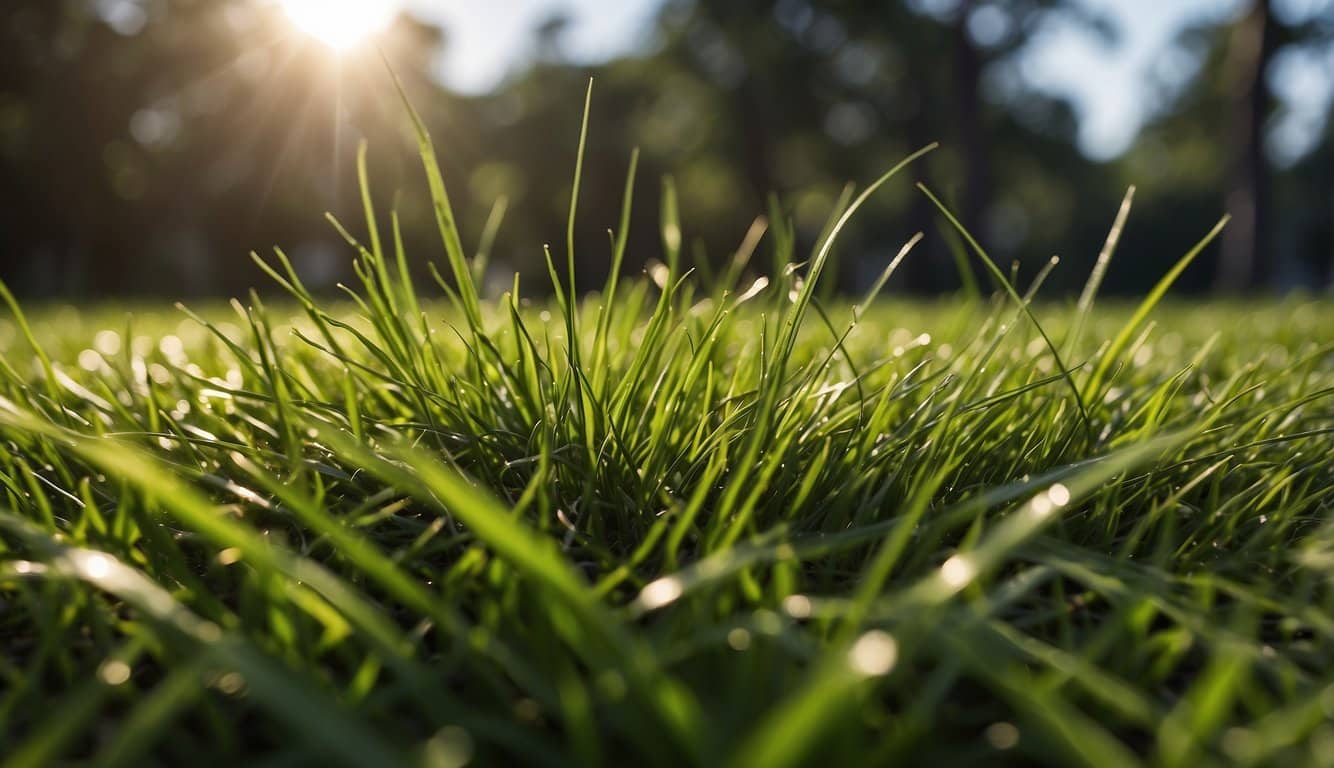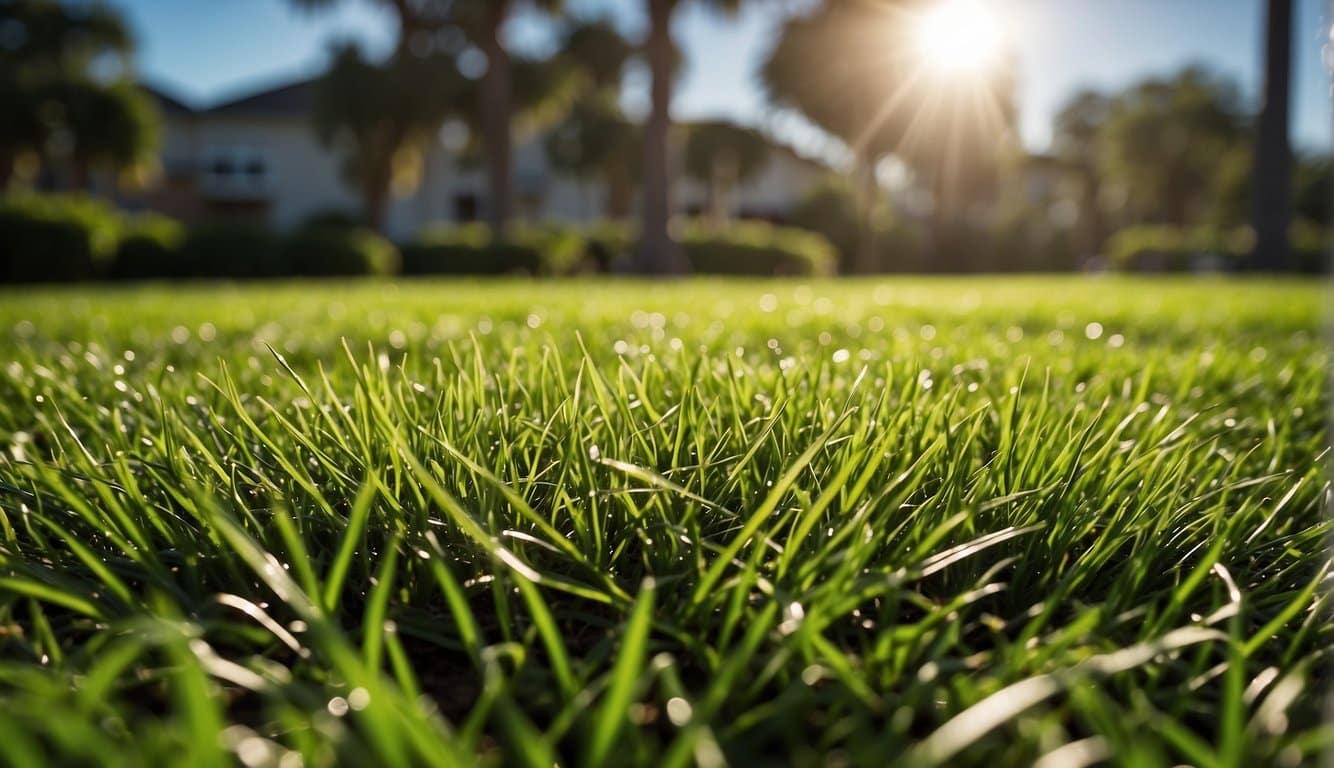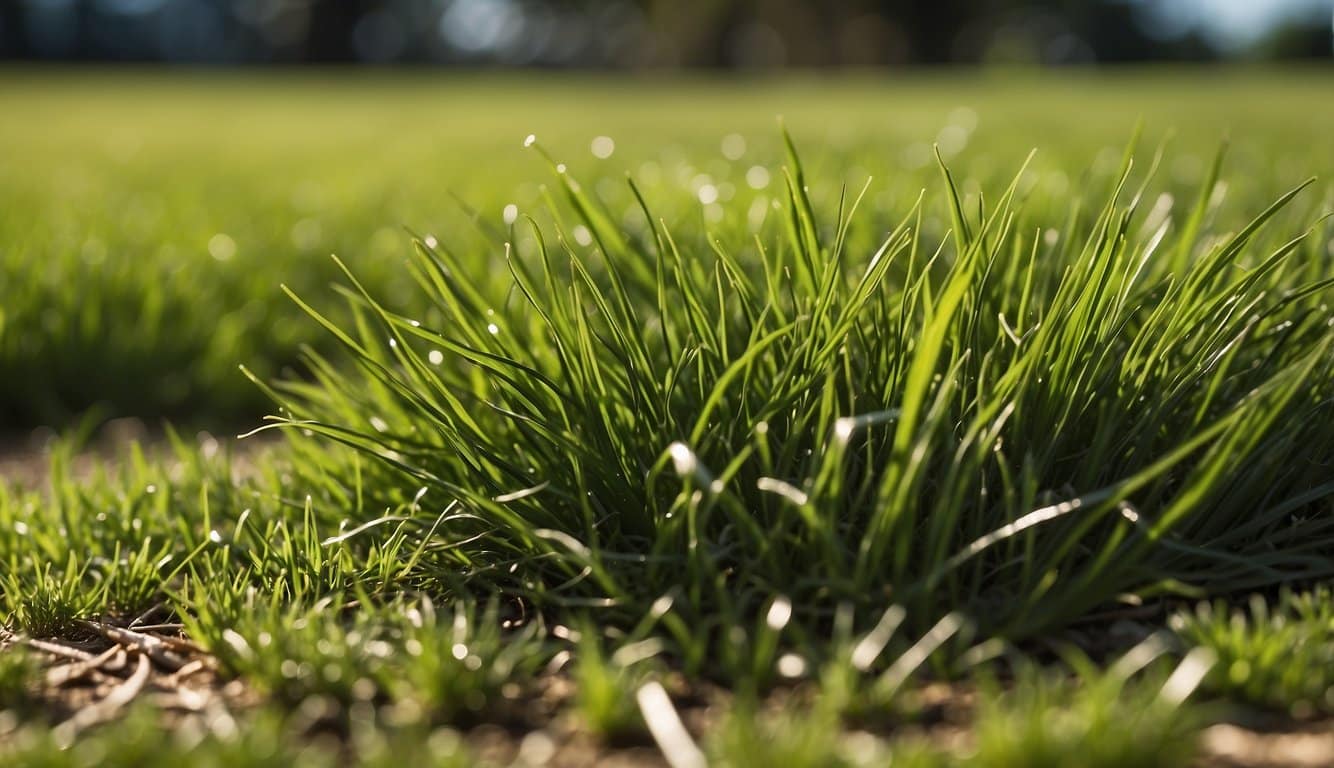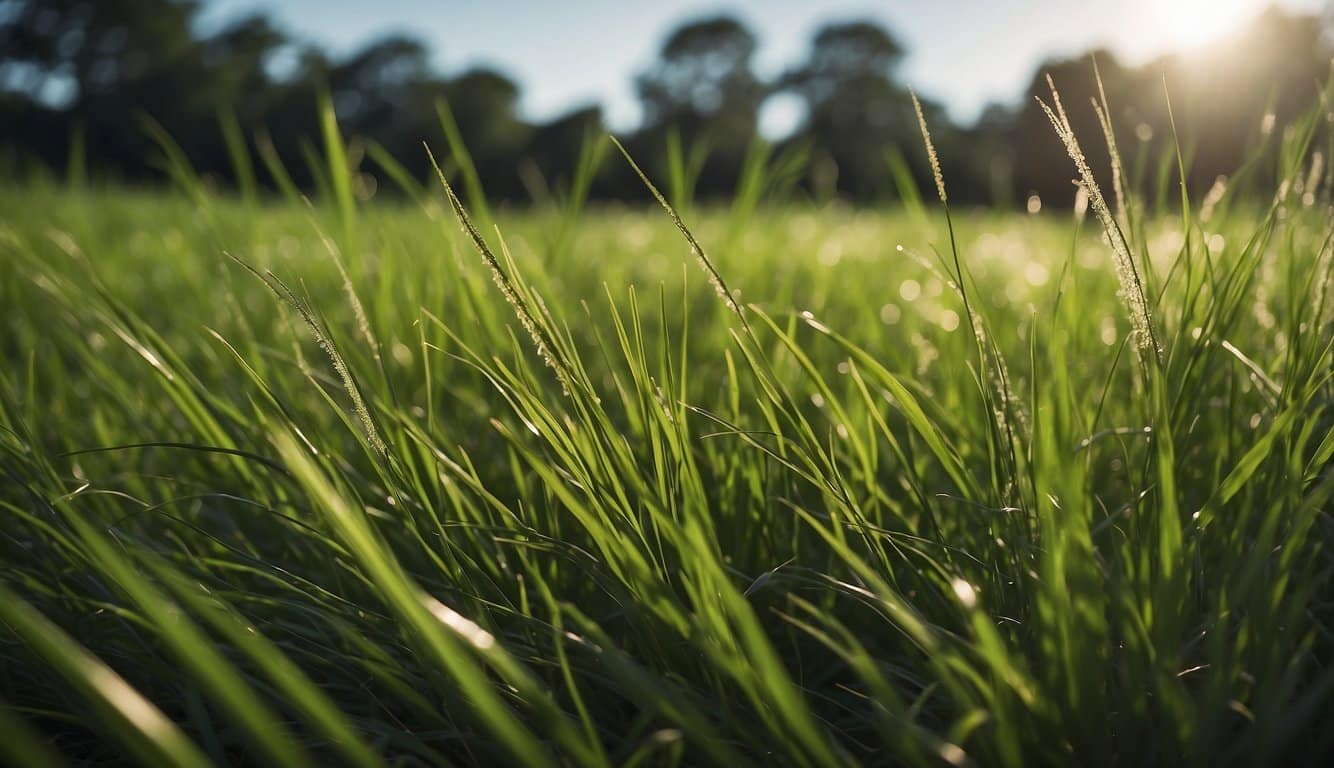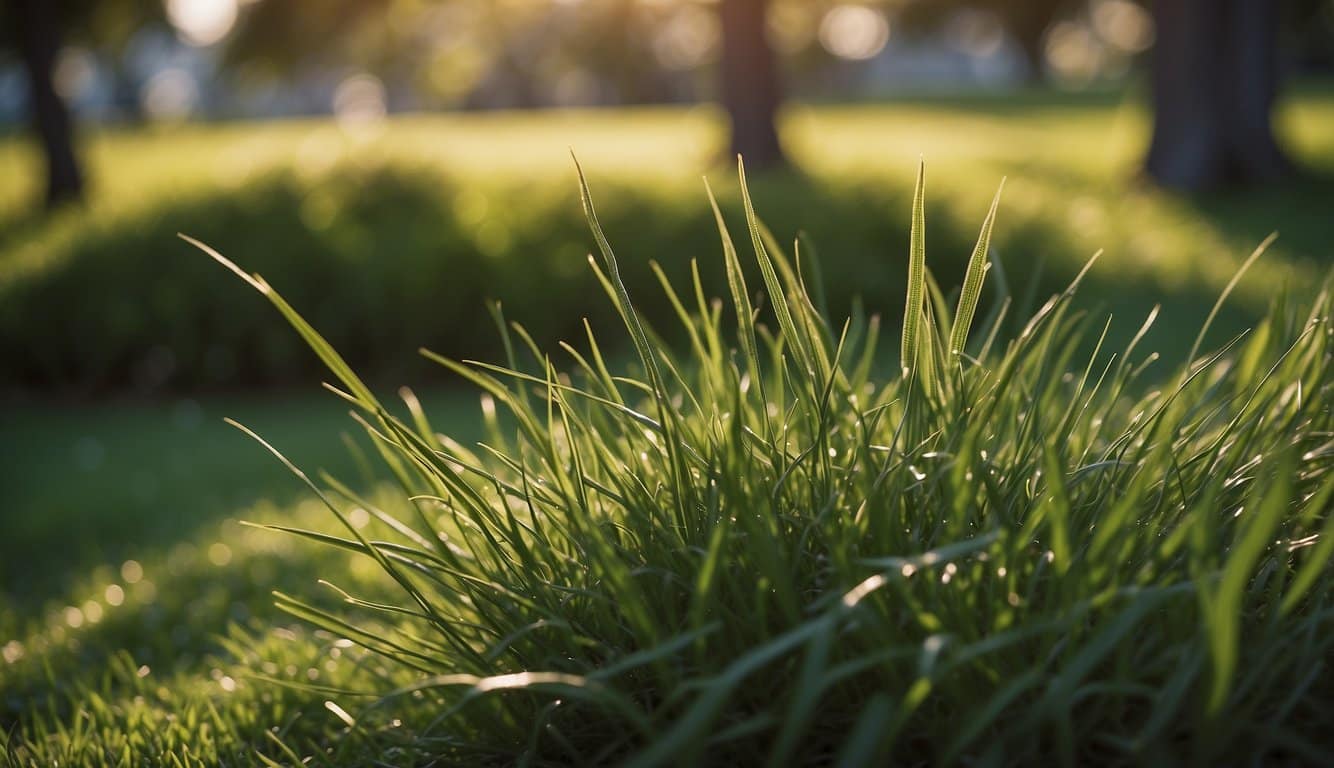Choosing the right type of grass for a lawn depends on several factors, including climate, soil conditions, maintenance preferences, and the intended use of the turf.
Two popular grass choices for lawns are St. Augustine and Tall Fescue, each with its own set of characteristics, advantages, and disadvantages.
St. Augustine grass flourishes in warm climates and is known for creating a dense turf that can endure heavy foot traffic. Its thick, carpet-like appearance adds to its appeal among homeowners in hotter regions.
On the other side of the spectrum is Tall Fescue, a grass that is well-suited for cooler climates. It’s recognized for its resilience and ability to handle traffic. It has a quicker recovery time after damage and is generally less costly in terms of both time and money when it comes to repair and maintenance.
With its deeper root systems, Tall Fescue also offers advantages in terms of drought resistance, which can be a crucial factor in areas with less consistent rainfall.
Key Takeaways
- St. Augustine grass excels in warm climates and withstands heavy foot traffic.
- Tall Fescue is better for cooler climates and is more cost-effective to maintain.
- Both grass types offer unique benefits and require consideration of climate, maintenance, and lawn use.
Overview of St. Augustine Grass
St. Augustine grass is renowned for creating a lush, thick turf that’s well-suited for warm climates. This section offers a closer look at its defining traits, climate preferences, and care needs.
Characteristics of St. Augustine Grass
St. Augustine grass sports wide, flat blades with a robust green color, providing yards with a dense ground cover. It achieves a carpet-like texture that can endure a fair amount of foot traffic.
Climate Tolerance
Preferred Temperature Range: St. Augustine thrives in temperatures between 80-95°F. As a warm-season turf, it’s ideal for tropical and subtropical regions, showing poor cold tolerance.
- Sun Exposure: It requires ample sunlight but can handle moderate shade.
- Heat Tolerance: Excellent, particularly in humid conditions.
Maintenance Requirements
Watering: St. Augustine demands consistent moisture, especially in the heat of summer.
Fertilization: Regular feeding throughout the growing season is crucial for sustained health and vigor.
- Mowing Frequency: St. Augustine lawn should be mowed regularly to a height of about 2.5 to 4 inches.
- Ongoing Care: It may need more care in terms of pest and disease management compared to some other grass types.
Overview of Tall Fescue
In this section, readers will gain insights into the specific characteristics of tall fescue, its adaptability to different climates, and the care and upkeep it requires to maintain a healthy appearance.
Characteristics of Tall Fescue
Tall fescue is known for its deep roots and coarse texture. It is a cool-season grass that forms a dense, dark-green lawn. The blades are wider compared to some other turfgrasses, which contributes to its robust appearance.
- Root System: Deep
- Blade Texture: Coarse
- Color: Dark green
Climate Adaptability
Tall fescue shows remarkable adaptability and can thrive in a wide pH range from 5.5 to 7.5. It performs best in regions with mild summers and cool winters, often preferred in transitional zones where temperatures fluctuate.
- Ideal pH: 5.5 to 7.5
- Best Climate: Mild summers, cool winters
- Zone Suitability: Transitional zones
Care and Upkeep
The maintenance of tall fescue can be less demanding in comparison to more sensitive warm-season grasses. It requires regular watering and benefits from fertilization but is tolerant to a variety of soil conditions and partial shade.
- Watering: Regular
- Fertilization: As needed
- Soil Tolerance: Various conditions
- Shade Tolerance: Moderate
Comparative Analysis
In this section, the distinct characteristics of St. Augustine and Tall Fescue grasses are dissected to assist homeowners in determining the best fit for their lawns, focusing specifically on their growth patterns, drought resilience, shade tolerance, and aesthetic qualities.
Growth Habits and Adaptation
St. Augustine grass thrives in warm, coastal regions, preferring temperatures between 80-95°F, and struggles in colder climates. It requires planting by plugs or sod due to its poor seed viability.
Tall Fescue, conversely, adapts well to a wide range of climates and can be easily established through seeding, making it versatile in both warm and cooler conditions.
Drought Resistance
Fescue generally exhibits good drought resistance with deeper root systems, allowing it to access moisture from deeper in the soil.
St. Augustine is less drought-tolerant and demands consistent moisture to maintain its health and appearance.
Shade Tolerance
When it comes to shade tolerance, St. Augustine can grow in moderately shaded areas, although it still requires a few hours of direct sunlight.
Tall Fescue prefers more sun but can tolerate some light shade, so long as it also receives ample sunlight throughout the day.
Texture and Color Differences
St. Augustine grass boasts wide, flat blades with a dark green hue, imparting a dense and lush look to lawns.
Tall Fescue presents a coarser texture with its narrower blades and generally exhibits a deep green shade that is less consistent than St. Augustine’s vibrant tone.
Cultivation and Installation
The process of cultivating and installing turfgrass significantly influences its subsequent growth and maintenance. St. Augustine and Tall Fescue require distinct approaches for successful installation and establishment.
Best Practices for St. Augustine
St. Augustine grass thrives in warm climates and is commonly initiated from plugs or sod, rather than seed. When installing St. Augustine, gardeners should:
- Prepare the soil properly by removing weeds and debris and adding a starter fertilizer.
- Install sod or plugs during its peak growing season, which is late spring or early summer, to encourage quick establishment.
- Keep the soil consistently moist for the first few weeks until the grass has firmly rooted.
Best Practices for Tall Fescue
Tall Fescue is a cool-season grass that is best established from seed, allowing it to be accessible for a DIY approach. To cultivate Tall Fescue, one should:
- Aerate and loosen the top 2-3 inches of soil.
- Sow the seed at the recommended rate and lightly rake it into the soil.
- Maintain even moisture in the soil until germination and root establishment.
Frequently Asked Questions
When choosing between St. Augustine and tall fescue grasses, homeowners should consider several key aspects such as climate preference, water needs, pest and disease resilience, traffic tolerance, shade tolerance, and lawn maintenance requirements.
What are the climate and soil preferences for St. Augustine compared to tall fescue?
St. Augustine grass thrives in warm, coastal areas with temperatures between 80-95°F and prefers sandy, acidic soils. It is ideal for tropical and subtropical regions.
On the other side, tall fescue favors cooler climates found in USDA zones 5b through 7 and adapts well to a variety of soil types, including clay and loamy soils.
How do the water requirements of St. Augustine grass differ from those of tall fescue?
St. Augustine grass requires a good deal of water to maintain its health and lush appearance, and may need additional irrigation during dry spells.
Tall fescue has a deep root system, which typically allows it to better withstand periods of drought, thereby requiring less frequent watering.
What is the resilience of St. Augustine and tall fescue to common lawn pests and diseases?
St. Augustine is susceptible to chinch bugs and fungal diseases such as brown patch.
These issues are more likely to occur when the grass is overwatered or poorly drained.
Tall fescue, while generally robust, can suffer from issues like fescue blight. It also needs proper care to prevent pests and disease.
Which grass type is more suitable for high traffic areas, St. Augustine or tall fescue?
Tall fescue grass boasts greater durability and can handle higher traffic better than St. Augustine.
It’s well-suited for areas such as playgrounds and sports fields.
St. Augustine, with its carpet-like density, can tolerate moderate traffic but may thin out in highly active areas.
How does the shade tolerance of St. Augustine compare to that of tall fescue?
St. Augustine grass has a good shade tolerance, making it a preferable option for lawns with partial sun exposure.
In contrast, tall fescue has moderate shade tolerance but performs best in full sunlight or light shade conditions.
What are the maintenance differences between St. Augustine grass and tall fescue lawns?
St. Augustine lawns often require regular watering, frequent mowing, and vigilant pest control. This generally makes it higher maintenance.
Tall fescue, however, while still needing proper care, usually uses less water and fertilizer. It is considered lower maintenance over time.
